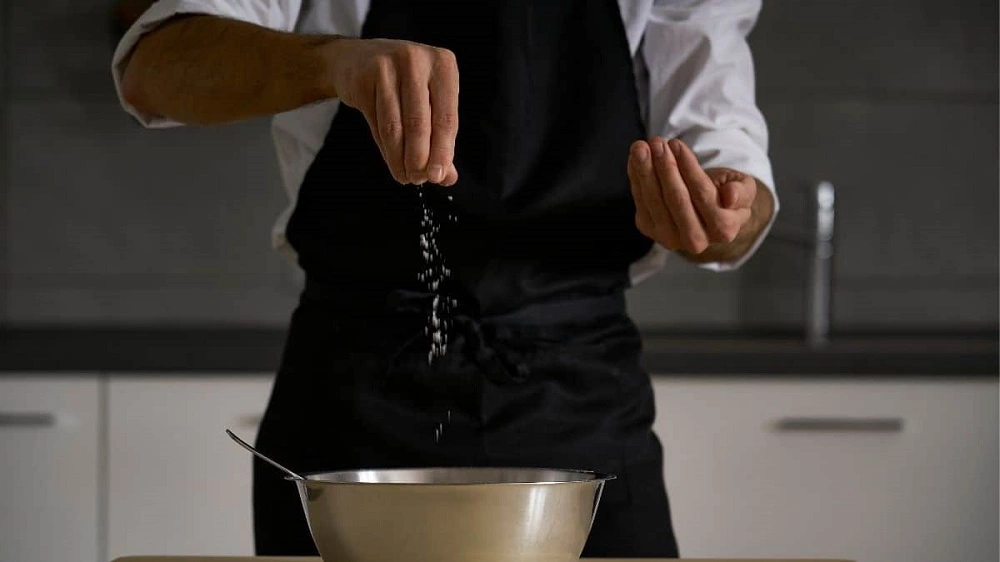
You invite friends for dinner, cook your special items, and in the excitement and anticipation of the moment, add that extra pinch of salt, spoiling all your plans. Well, you don’t have to fear this scenario anymore. Here’s all you need to know about fixing that extra salt.
“Excess amount of salt in food items can be fixed by neutralizing them with salt-absorbing ingredients like acidic items (lemon juice, vinegar), vegetables (potato, leafy greens), dairy products, sugar etc.”
The saltiness in food can also be fixed by methods such as doubling the quantity and adding mild flavors or condiments to the recipe.
Salt, called “the white gold”, is no villain, if used in proper measure. In fact, from being a preservative and flavor enhancer to a nutrient and binder, salt has 14,000 uses across different fields. So, the key is to know how to prevent food from getting too salty and to know how to fix salty food if ever a salt mishap happens.
The methods to fix salty foods are actually methods that make use of food or cooking materials already available in your kitchen such as vinegar, bread crumbs, rice, sugar, vegetables, dairy products, condiments, etc. However, each of these ingredients has its own specific occasions of use, and here we explain all of them in detail to you.
Table of Contents
- Acid
- Water
- Dairy products
- Sugar
- Potato
- Starch (Rice, Bread)
- Increase The Amount To Fix Saltiness
- Tips To Prevent Food From Getting Too Salty
- How To Fix Salty Meat Or Fish?
- How To Fix Salty Soup?
- How To Fix The Saltiness In Mashed Potatoes?
- How To Fix Salty Vegetables?
- How To Fix Salty Mushrooms?
- How To Fix The Saltiness Of Boiled Grains?
- Fixing Salty Food – Summary And My Opinion
Acid
One of the easiest ways to neutralize excess salt content in food is to add food ingredients that are acidic in nature. If you sprinkle some lemon juice and vinegar into the salty food, the saltiness will be gone instantly.
You can also use tomato pieces or tomato sauce to reduce the saltiness as tomatoes are also acidic in nature. However, you have to keep in mind that these acidic ingredients should not mess up the flavor of your food item.
For instance, if your mashed potatoes are way too salty, you can balance them out with some lemon juice. But if you add excess lemon juice, the potatoes might taste too sour or bitter.
Water
Adding some extra water is a good rescue operation to fix saltiness, especially in the case of sauce, soups, and curries.
When you add water, keep in mind that water has to be added in steps, and not all at once. You add some water, taste the food for saltiness, and repeat the process until you reach a satisfying level of saltiness.
In case, the addition of water has made your food item too loose, diluted, or watery, what you can do is keep heating the food openly on a low burner for a few minutes so that the excess water will be evaporated.
Dairy products
In case your food item already has a dairy content (like creamy pasta) or can be flavored with a dairy content (like tomato sauce), the addition of dairy products like milk, cheese, cream, butter, etc. is a good way to fix salty food.
One thing you should know is that these dairy products do not remove the salt content from the odd; instead, the fat content in the dairy product act as a coating that covers our taste buds and prevents us from sensing the salty flavor.
Because of this specialty, dairy products like cream and cheese can be used as a topping while you serve salty foods. Suppose your bacon or sandwich is too salty, you can add a whip of cream as a topping to your bacon or a slice of cheese to compliment the burger. Do not forget to make sure that the cheese you are using is not salty one.
Sugar
In certain dishes, especially sauces, soups, and those which have gravy, you can balance the excess salt content by adding sugar. When sugar is added, the sweet flavor of sugar mildens the savory flavor that comes with excess salt.
However, be very careful while adding sugar because excess sugar can make your dish too sweet and thus mess up the intended flavor of your food item. Add a pinch of sugar and taste the dish to know the level of saltiness.
Besides, see to it that the sugar is thoroughly mixed in with the dish so that you won’t end up with lumps of sugary and salty flavor in your dish.
Potato
In case you cannot make your over-salty dishes like soups, sauces, or stew more dilute by adding liquids like water or vinegar, the best option is to add a potato to absorb the salty liquid from the dish.
Although there is still debate over the effectiveness of this method, potato still remains a go-to material in grandma’s techniques of absorbing excess salt.
You can add either an uncut, raw potato or sliced pieces of raw potato to the salty soup or curry and let it simmer for a few minutes. Take the softened, salty potato away later.
Starch (Rice, Bread)
Similar to starch-rich potatoes, you can also make use of starchy items like rice, bread, pasta, quinoa, or couscous to balance out the saltiness of a food item.
Adding some cooked, unseasoned white rice to an oversalted stew or soup will help you lower the salinity of the dish without having to add excess water content. Similarly, you can use a slice of bread to soak up the saline liquid although you should be careful that the bread doesn’t get dissolved into the dish.
Increase The Amount To Fix Saltiness
If none of the above methods does not work for you, the alternate option is to increase the amount of food. In this method, you cook extra food with the same recipe but do not add salt. After this, you mix this new half with the over-salty portion to balance out the saltiness.
While all the above-listed techniques are effective in their capacity, the best strategy to get a balanced flavor is to avoid your dish from getting salty in the first place. Prevention is better than cure, the old saying goes. Therefore, let us see what are the ways in which you can prevent your food from getting salty.
Tips To Prevent Food From Getting Too Salty
The most useful tips for preventing food items from getting over-salty are listed as follows:
- Add salt in steps: You don’t have to add the total amount of salt all at once. You add a pinch of salt, taste the dish, and add again accordingly.
- Salt as the latecomer: Cooking experts suggest that in the case of most dishes, salt can be added towards the end of the preparation of the food. This is so because the amount of salt can be adjusted to the overall final flavor of the dish.
- Salt Shaker on the table: As salt is an ingredient that people adjust according to both their taste preferences and health conditions, an effective method is to not add salt to the dish but keep a salt shaker on the table. With the shaker, people can add salt according to their measurements.
- Checking the salt shaker lid: If you are using a salt shaker to add salt to your food, you should always check the lids of the shaker. The amount of salt that comes out of the shaker depends on the extent to which the holes in the lids are opened. Also, make sure that the lid is tight before each use. Nobody likes the sight of a white salty hill on their favorite dish.
- Measure away from the dish: Some people have the tendency to measure the amount of salt right on top of the food being cooked. This can result in excess salt being spilled over the food. Therefore, measure the salt away from where the food is being prepared.
- Measure for Measure: Each food ingredient has its own particular measure of absorbing salt. Potatoes and eggs, for instance, may require more salt than, say, rice or tomatoes. Therefore, be mindful of the kind of ingredients you use while measuring the salt required.
Now that we know how to avoid food getting salty and how to fix the saltiness of food in case it gets too salty, let us look at what we can do in the case of specific food items.
How To Fix Salty Meat Or Fish?

Salty meat that you ordered online, or that perfect piece of fish from that online store, can be fixed using different methods such as rinsing it in water, adding lemon juice, adding sugar or butter, mixing onion paste, having cream as a side dish, and so on. They are explained in detail below.
- Water on Salty Meat: If the excess salt content was added during the marinating process, you can wash it away using water. You can either wipe it off with a wet towel or rinse it off by placing it under running water for a brief period.
- Sugar to fix salty meat: If the excess saline flavor was detected using the preparation process, you can add some sugar to balance the flavor.
- Butter to fix salty meat: Similar to sugar, you can add a piece of butter to deal with saltiness in meat dishes.
- Potato or Onion to fix salty meat: Provided it won’t interfere with the overall flavor of your dish, you can add grated potato or blended onion to neutralize the saline flavor of your meat dish.
- Lemon juice to fix salty meat: Adding a sprinkle of lemon juice to your over-salty meat is also an effective method. But, be careful that you don’t add too much lemon juice, lest it gets sour.
- A creamy side dish to fix salty meat: If none of the above methods are feasible for you and your dish is still salty in its final stage, what you can do is have a creamy sauce or any other side dish that takes away or covers up the saline flavor of the main dish.
How To Fix Salty Soup?
Salty soups can be fixed by neutralizing them with items such as boiling water, broth, vegetables, sugar, green vegetables, rice, etc. The neutralizing ingredient you should use depends on the nature of the soup you’re making.
If it’s a regular, not-so-thick soup you can add boiling water. If it’s supposed to be thick, you can add excess but unsalted broth. If it is a creamy soup that you have over-salted, try to add more cream. In other cases, you can throw in some sugar, pasta, or vegetables.
Adding cooked rice is also a feasible option, but take care to get rid of the rice from your soup after the rice has absorbed the salt content.
How To Fix The Saltiness In Mashed Potatoes?
The excess salt in mashed potatoes can be fixed using the following techniques:
- You can sprinkle some lemon juice onto the salty mashed potatoes. If used at a moderate level, lemon can give a special flavor to your mashed potatoes as well.
- You can add milk or cream to balance the salt content. This also depends on the kind of ingredients you are using in the dish.
- Alternatively, you can add butter or sugar. It is also effective to beat a fresh egg into the recipe.
- Besides these methods, you can cook one or two extra potatoes and mash them along with the salty mashed potatoes.
How To Fix Salty Vegetables?

Salty vegetables can be fixed in the following ways:
- If it is a vegetable stew or curry, you can add potato or parsley twigs to it so that the salt water will be absorbed. They will also leave a special aroma while they are removed from the dish.
- You can also balance the saltiness of vegetables by mixing them up with cheese like mozzarella
- You can also double the amount of vegetables used by adding unsalted vegetables.
Also read: https://couchpotatodelivery.com/why-you-should-eat-more-vegetables/
How To Fix Salty Mushrooms?
Salty mushrooms can be fixed by:
- Adding a whip of sour or heavy cream while the mushrooms are sautéed on the stove
- Adding boiling water that is mixed with a few drops of lemon juice.
How To Fix The Saltiness Of Boiled Grains?
If the boiled grains have become too salty, you can fix it by rinsing the boiled beans under cold water for a while and boiling them again after the excess salt is rinsed off from them. The same technique of rinsing with water can be used in case a situation of over-salty pasta comes up.
Fixing Salty Food – Summary And My Opinion
There’s a legend that the Roman soldiers were paid in salt and that the word salary is derived from this association. Be it true or not, salt is an essential white gold in our kitchen.
However, this white gold has to be always used cautiously and judiciously. But in case you err in adding the salt, there are still a number of easy, healthy options to deal with the saline flavor.
Adding the right amount of salt can be extra tricky when you are cooking with children. So, watch them carefully when they are adding that to the dish they are cooking.
